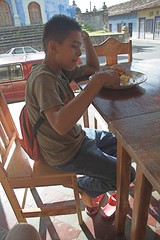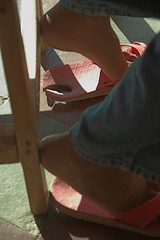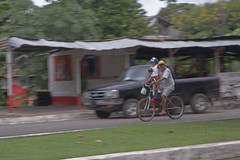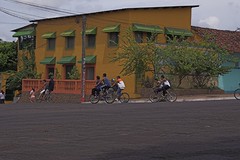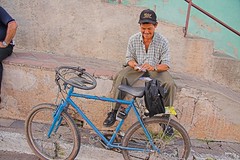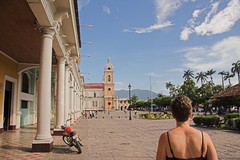Informal Economics
Gerardo sells gum. He walks around the old center of Granada looking for people to buy little packs of Chiclets for one cordoba each. At 10 he's a savvy salesman, although he has no formal education and doesn't go to school because he can't afford any of the necessary supplies, including leather shoes, a school uniform, a notebook and pencils. I saw Gerardo the other day and we sat together for a while and talked. I learned a lot about the informal economy--at least from Gerardo's perspective.
The day we talked, Gerardo was toting a 100-pack box of gum, about two thirds of which he'd already sold. The box costs 40 cordobas (approximately $2.50). Selling the box of 100 at a cordoba a piece, he makes a 60 cordoba profit. But for a poor street seller like Gerardo--who that day had on flip-flops so old and worn out that he'd scuffed a hole in the heel--that's a lot of money. When we met that day (Friday), he had about 35 packets of gum left in the box. This morning (Monday) he sold me the remaining six packets. That suggests that he sells roughly 10 packets each day. So every ten days he finishes up a box, pockets 60 cordobas and reinvests the other 40 in a new box. At the end of the year, after a hard work every day, he's probably made 2,190 cordobas, or about $135.
Given this level of poverty, I wondered how Gerardo gathered enough money to buy that first 100-box of gum. He bought it, he said, at the market after having saved up the necessary money. He explained that he used to sell sticks of gum, little candies, cigarettes and the like from a small basket. He bought and sold on a small scale. The returns were far less, but his up-front costs were more feasible. Still, this also meant wasting time going back and forth to the market every day or so.
Gerardo started on the streets when he was just 7. He had no money and thus had nothing to sell; so he begged. From these first few cordobas, he has moved steadily toward larger and more profitable selling. He's a micro-entrepreneur who has been increasingly successful. Yet he still lives in desperately poor conditions and malnutrition has left him small for his age. Moreover, he is largely at the end of his mobility. He could conceivably move onto larger and more profitable goods like jewelry or ceramics, but these are very different businesses with enormous initial costs and an uncertain future. These things are subject to taste and the purchase of tourists. Gum and cigarettes are fungible items and always desired. More importantly, they are bought by Nicaraguans as well as foreigners.
It is unlikely that he will beat the odds that poverty has dealt him. The life of kids like Gerardo is often marked by drug addiction (especially glue sniffing), disease, and physical and sexual abuse. I offer Gerardo's story not as a romantic tale of a Nicaraguan Horatio Alger, but rather as both the inspiring qualities of human creativity and doggedness in the most dire of circumstances and the real structural impediments to even so amazing a kid as Gerardo.
The day we talked, Gerardo was toting a 100-pack box of gum, about two thirds of which he'd already sold. The box costs 40 cordobas (approximately $2.50). Selling the box of 100 at a cordoba a piece, he makes a 60 cordoba profit. But for a poor street seller like Gerardo--who that day had on flip-flops so old and worn out that he'd scuffed a hole in the heel--that's a lot of money. When we met that day (Friday), he had about 35 packets of gum left in the box. This morning (Monday) he sold me the remaining six packets. That suggests that he sells roughly 10 packets each day. So every ten days he finishes up a box, pockets 60 cordobas and reinvests the other 40 in a new box. At the end of the year, after a hard work every day, he's probably made 2,190 cordobas, or about $135.
Given this level of poverty, I wondered how Gerardo gathered enough money to buy that first 100-box of gum. He bought it, he said, at the market after having saved up the necessary money. He explained that he used to sell sticks of gum, little candies, cigarettes and the like from a small basket. He bought and sold on a small scale. The returns were far less, but his up-front costs were more feasible. Still, this also meant wasting time going back and forth to the market every day or so.
Gerardo started on the streets when he was just 7. He had no money and thus had nothing to sell; so he begged. From these first few cordobas, he has moved steadily toward larger and more profitable selling. He's a micro-entrepreneur who has been increasingly successful. Yet he still lives in desperately poor conditions and malnutrition has left him small for his age. Moreover, he is largely at the end of his mobility. He could conceivably move onto larger and more profitable goods like jewelry or ceramics, but these are very different businesses with enormous initial costs and an uncertain future. These things are subject to taste and the purchase of tourists. Gum and cigarettes are fungible items and always desired. More importantly, they are bought by Nicaraguans as well as foreigners.
It is unlikely that he will beat the odds that poverty has dealt him. The life of kids like Gerardo is often marked by drug addiction (especially glue sniffing), disease, and physical and sexual abuse. I offer Gerardo's story not as a romantic tale of a Nicaraguan Horatio Alger, but rather as both the inspiring qualities of human creativity and doggedness in the most dire of circumstances and the real structural impediments to even so amazing a kid as Gerardo.

